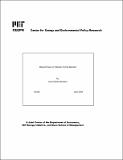| dc.contributor.author | Montero, Juan Pablo | |
| dc.date.accessioned | 2010-02-09T19:20:12Z | |
| dc.date.available | 2010-02-09T19:20:12Z | |
| dc.date.issued | 2009-04 | |
| dc.identifier.issn | 2009-006 | |
| dc.identifier.uri | http://hdl.handle.net/1721.1/51668 | |
| dc.description.abstract | As with other commodity markets, markets for trading pollution permits have not been immune to market power concerns. In this paper, I survey the existing literature on market power in permit trading but also contribute with some new results and ideas. I start the survey with Hahn’s (1984) dominant-firm (static) model that I then extend to the case in which there are two or more strategic firms that may also strategically interact in the output market, to the case in which current permits can be stored for future use (as in most existing and proposed market designs), to the possibility of collusive behavior, and to the case in which permits are auctioned off instead of allocated for free to firms. I finish the paper with a review of empirical evidence on market power, if any, with particular attention to the U.S. sulfur market and the Southern California NOx market. | en |
| dc.description.sponsorship | Massachusetts Institute of Technology. Center for Energy and Environmental Policy Research. | en |
| dc.language.iso | | en |
| dc.publisher | MIT Center for Energy and Environmental Policy Research | en |
| dc.relation.ispartofseries | MIT-CEEPR;09-006 WP | |
| dc.title | Market Power in Pollution Permit Markets | en |
| dc.type | Working Paper | en |
| dc.audience.educationlevel | | |
